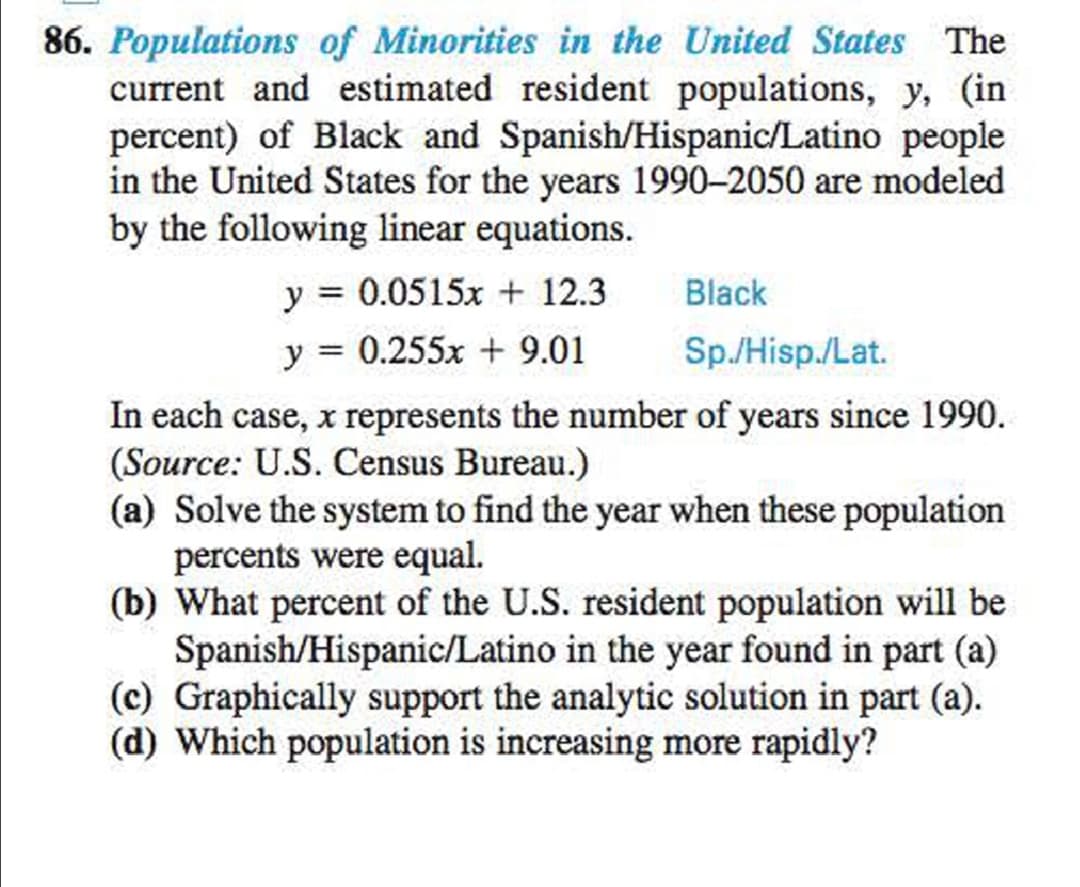86. Populations of Minorities in the United States The current and estimated resident populations, y, (in percent) of Black and Spanish/Hispanic/Latino people in the United States for the years 1990-2050 are modeled by the following linear equations. y = 0.0515x + 12.3 Black y = 0.255x + 9.01 Sp./Hisp./Lat. In each case, x represents the number of years since 1990. (Source: U.S. Census Bureau.) (a) Solve the system to find the year when these population percents were equal. (b) What percent of the U.S. resident population will be Spanish/Hispanic/Latino in the year found in part (a) (c) Graphically support the analytic solution in part (a). (d) Which population is increasing more rapidly?
86. Populations of Minorities in the United States The current and estimated resident populations, y, (in percent) of Black and Spanish/Hispanic/Latino people in the United States for the years 1990-2050 are modeled by the following linear equations. y = 0.0515x + 12.3 Black y = 0.255x + 9.01 Sp./Hisp./Lat. In each case, x represents the number of years since 1990. (Source: U.S. Census Bureau.) (a) Solve the system to find the year when these population percents were equal. (b) What percent of the U.S. resident population will be Spanish/Hispanic/Latino in the year found in part (a) (c) Graphically support the analytic solution in part (a). (d) Which population is increasing more rapidly?
Linear Algebra: A Modern Introduction
4th Edition
ISBN:9781285463247
Author:David Poole
Publisher:David Poole
Chapter2: Systems Of Linear Equations
Section2.4: Applications
Problem 17EQ
Related questions
Concept explainers
Equations and Inequations
Equations and inequalities describe the relationship between two mathematical expressions.
Linear Functions
A linear function can just be a constant, or it can be the constant multiplied with the variable like x or y. If the variables are of the form, x2, x1/2 or y2 it is not linear. The exponent over the variables should always be 1.
Question
Solve 86

Transcribed Image Text:86. Populations of Minorities in the United States The
current and estimated resident populations, y, (in
percent) of Black and Spanish/Hispanic/Latino people
in the United States for the years 1990-2050 are modeled
by the following linear equations.
y = 0.0515x + 12.3
Black
y = 0.255x + 9.01
Sp./Hisp./Lat.
In each case, x represents the number of years since 1990.
(Source: U.S. Census Bureau.)
(a) Solve the system to find the year when these population
percents were equal.
(b) What percent of the U.S. resident population will be
Spanish/Hispanic/Latino in the year found in part (a)
(c) Graphically support the analytic solution in part (a).
(d) Which population is increasing more rapidly?
Expert Solution
This question has been solved!
Explore an expertly crafted, step-by-step solution for a thorough understanding of key concepts.
This is a popular solution!
Trending now
This is a popular solution!
Step by step
Solved in 5 steps with 10 images

Knowledge Booster
Learn more about
Need a deep-dive on the concept behind this application? Look no further. Learn more about this topic, algebra and related others by exploring similar questions and additional content below.Recommended textbooks for you

Linear Algebra: A Modern Introduction
Algebra
ISBN:
9781285463247
Author:
David Poole
Publisher:
Cengage Learning

Algebra & Trigonometry with Analytic Geometry
Algebra
ISBN:
9781133382119
Author:
Swokowski
Publisher:
Cengage

Linear Algebra: A Modern Introduction
Algebra
ISBN:
9781285463247
Author:
David Poole
Publisher:
Cengage Learning

Algebra & Trigonometry with Analytic Geometry
Algebra
ISBN:
9781133382119
Author:
Swokowski
Publisher:
Cengage